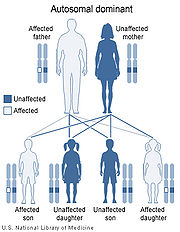
Platyspondylic lethal skeletal dysplasia, Torrance type
Encyclopedia
Platyspondylic lethal skeletal dysplasia, Torrance type is a severe disorder of bone
growth. People with this condition have very short arms and legs, a small chest with short ribs, underdeveloped pelvic bones, and unusually short fingers and toes (brachydactyly
). This disorder is also characterized by flattened spinal bones (platyspondyly) and abnormal curvature of the spine (lordosis
).
As a result of these serious skeletal problems, many infants with platyspondylic lethal skeletal dysplasia, Torrance type are born prematurely, are stillborn, or die shortly after birth from respiratory failure. A few affected people with milder signs and symptoms have lived into adulthood, however.
This condition is one of a spectrum of skeletal disorders caused by mutations in the COL2A1
gene. This gene provides instructions for making a protein that forms type II collagen
. This type of collagen is found mostly in cartilage
and in the clear gel that fills the eyeball (the vitreous
). It is essential for the normal development of bones and other tissues that form the body's supportive framework (connective tissue
s).
Mutations in the COL2A1 gene interfere with the assembly of type II collagen molecules, resulting in a reduced amount of this type of collagen in the body. Instead of forming collagen molecules, the abnormal COL2A1 protein builds up in cartilage cells (chondrocytes). These changes disrupt the normal development of bones and other connective tissues, leading to the skeletal abnormalities characteristic of platyspondylic lethal skeletal dysplasia, Torrance type.
 This condition is inherited in an autosomal dominant pattern, which means one copy of the altered gene in each cell is sufficient to cause the disorder. In some cases, an affected person inherits the mutation from one affected parent. Other cases may result from new mutations in the gene. These cases occur in people with no history of the disorder in their family.
This condition is inherited in an autosomal dominant pattern, which means one copy of the altered gene in each cell is sufficient to cause the disorder. In some cases, an affected person inherits the mutation from one affected parent. Other cases may result from new mutations in the gene. These cases occur in people with no history of the disorder in their family.
Bone
Bones are rigid organs that constitute part of the endoskeleton of vertebrates. They support, and protect the various organs of the body, produce red and white blood cells and store minerals. Bone tissue is a type of dense connective tissue...
growth. People with this condition have very short arms and legs, a small chest with short ribs, underdeveloped pelvic bones, and unusually short fingers and toes (brachydactyly
Brachydactyly
Brachydactyly , is a medical term which literally means "shortness of the fingers and toes" . The shortness is relative to the length of other long bones and other parts of the body. Brachydactyly is an inherited, usually dominant trait...
). This disorder is also characterized by flattened spinal bones (platyspondyly) and abnormal curvature of the spine (lordosis
Lordosis
Lordosis is a medical term used to describe an inward curvature of a portion of the lumbar and cervical vertebral column. Two segments of the vertebral column, namely cervical and lumbar, are normally lordotic, that is, they are set in a curve that has its convexity anteriorly and concavity...
).
As a result of these serious skeletal problems, many infants with platyspondylic lethal skeletal dysplasia, Torrance type are born prematurely, are stillborn, or die shortly after birth from respiratory failure. A few affected people with milder signs and symptoms have lived into adulthood, however.
This condition is one of a spectrum of skeletal disorders caused by mutations in the COL2A1
COL2A1
Collagen, type II, alpha 1 , also known as COL2A1, is a human gene that provides instructions for the production of the pro-alpha1 chain of type II collagen....
gene. This gene provides instructions for making a protein that forms type II collagen
Collagen
Collagen is a group of naturally occurring proteins found in animals, especially in the flesh and connective tissues of mammals. It is the main component of connective tissue, and is the most abundant protein in mammals, making up about 25% to 35% of the whole-body protein content...
. This type of collagen is found mostly in cartilage
Cartilage
Cartilage is a flexible connective tissue found in many areas in the bodies of humans and other animals, including the joints between bones, the rib cage, the ear, the nose, the elbow, the knee, the ankle, the bronchial tubes and the intervertebral discs...
and in the clear gel that fills the eyeball (the vitreous
Vitreous humour
The vitreous humour or vitreous humor is the clear gel that fills the space between the lens and the retina of the eyeball of humans and other vertebrates...
). It is essential for the normal development of bones and other tissues that form the body's supportive framework (connective tissue
Connective tissue
"Connective tissue" is a fibrous tissue. It is one of the four traditional classes of tissues . Connective Tissue is found throughout the body.In fact the whole framework of the skeleton and the different specialized connective tissues from the crown of the head to the toes determine the form of...
s).
Mutations in the COL2A1 gene interfere with the assembly of type II collagen molecules, resulting in a reduced amount of this type of collagen in the body. Instead of forming collagen molecules, the abnormal COL2A1 protein builds up in cartilage cells (chondrocytes). These changes disrupt the normal development of bones and other connective tissues, leading to the skeletal abnormalities characteristic of platyspondylic lethal skeletal dysplasia, Torrance type.


